
views
X
Research source
Getting a Diagnosis From the Vet

Ask the vet about the difference between eye discharge and an eye infection. Though eye discharge and other irritated eye symptoms may appear unpleasant or uncomfortable for your dog, they are not a clear sign of an eye infection. Your dog may have eye discharge due to a foreign substance in his eye, allergies, a scratch on his eye, or a condition called dry eye. He could also have a tear duct obstruction, an ulcer or tumor on his eye, or a genetic issue where his eyes protrude or his eyelids turn in. The only way for you to know for certain if your dog has an eye infection is to get his eyes examined by the vet.
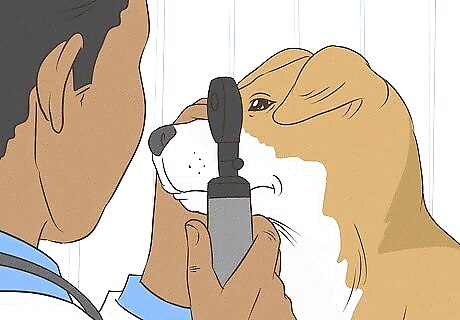
Let the vet examine your dog’s eyes. Your vet will first take your dog’s temperature and observe her as she walks or moves around the exam room. This will help the vet determine if there are issues with her eyesight due to the eye infection. The vet will then exam her irritated eye or eyes using an ophthalmoscope, which is a light instrument that will help the vet see the structures of your dog’s eyes. The vet can then note if there are any foreign objects, tumors, or abnormalities in her eye. The vet will examine her eye for issues around her eye, like swelling or paralysis. Then, the vet will look in her eye for any redness in the eye whites or the tissues around her eyeball and check if the discharge is colored or thick. The vet will also check to see if your dog is blinking normally and responding to movements in front of her face, like a hand moving towards her. Your vet should also note if her pupils are responding normally to light and to darkness.

Make sure the vet runs eye tests on your dog. Your vet may also run eye tests to confirm your dog’s eye infection. These tests include: A fluorescein stain: In this test, your vet will use a chemically treated strip of paper on your dog’s eye. The chemical, fluorescein, will appear green in areas of the eye that are injured with a scratch or an ulcer. The Schirmer tear test: This test will measure the tear production of your dog’s eye. In this quick and easy test, your vet will place a test strip on your dog’s eye to measure the tear production. This will help your vet determine if your dog’s eye is producing a normal amount of tears or if it has greatly increased or decreased due to an infection.
Treating the Infection

Use a warm washcloth to wipe discharge from your dog’s eye. You should remove the discharge that accumulates from the fur around your dog’s infected eye with a warm washcloth. However, you should not use the cloth to clean the eye itself, as you can scratch his eyeball and possibly damage his eye.
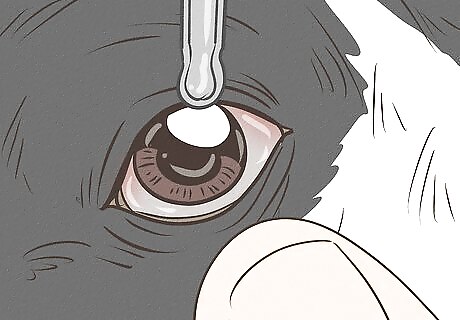
Flush your dog’s eye with saline solution. Saline solution can help to flush your dog’s eye and reduce any irritation in the eye. Use an eyedropper to drop solution into her eye three to four times a day.

Give your dog prescribed antibiotics. Your vet should prescribe antibiotics to help treat the eye infection. You may be given antibiotics in the form of drops or an ointment, which should be applied to the infected eye three to four times a day. Your vet may give your oral antibiotics, which you will need to give your dog via his food. When giving your dog medicated drops or ointment, follow this procedure: Have someone hold the dog steady. Get everything ready. Hold the eyelid open. Approach from behind the eye so the dog doesn't shy away. Avoid touching the surface of the eye with the tip of the dropper or tube. Allow the dog to blink to spread the ointment. Repeat at the prescribed interval.

Put your dog in a cone if she tries to scratch or paw at her eye. It’s important that you protect your dog’s eye from being scratched or rubbed. If she tries to rub her eye with her paws or rub it against other surfaces, she may need to be put into a cone or an Elizabethan collar to prevent her from further damaging her eye. You should also not allow your dog to put her head out of the car window when the car is moving, as bugs and debris can hit her infected eye and make it more irritated.
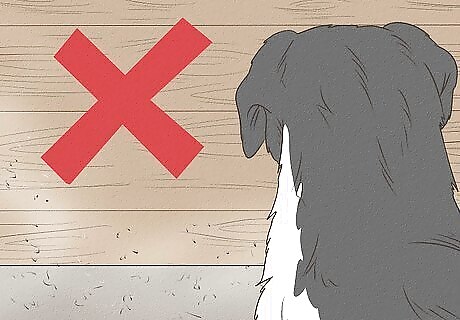
Keep him away from dusty environments. Try not to let your dog in dusty rooms or areas while the infected eye is healing. You should also prevent him from hanging out in dusty environments to prevent the development of an eye infection.













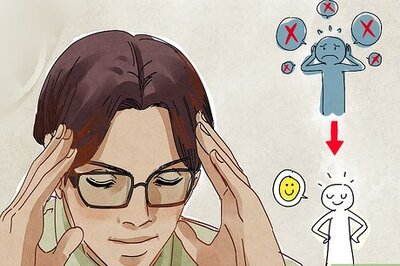





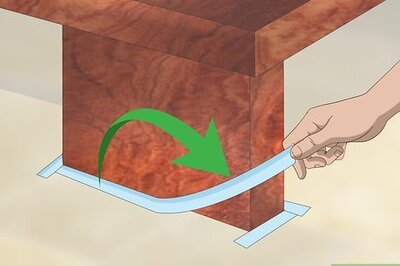
Comments
0 comment